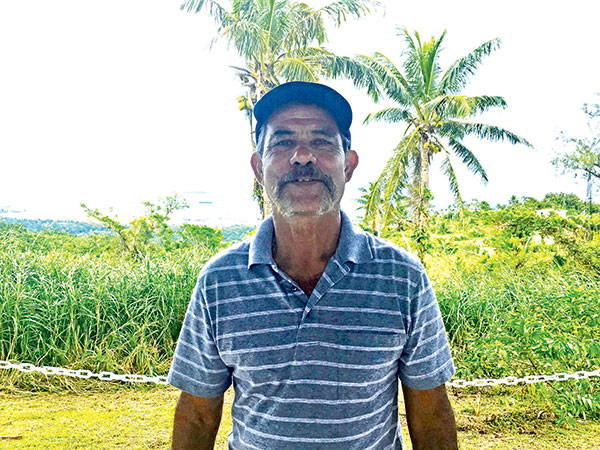EUSEBIO CAMACHO BORJA
A master of arts and culture

Eusebio Camacho Borja is named CNMI Master of Arts and Culture for his work in preserving traditional cultural practices by promoting the use of the traditional ox-cart (karetan guaka). (IVA MAURIN)
Today’s spotlight is trained on a man who actually needs no introduction. He is well known on the island. But then again, Eusebio Camacho Borja wants nothing more but to make everyone happy. “I want people to be happy. I like to make people happy.”
He does this by sharing his passion for the CNMI’s culture, like making available his ox-cart for bull rides, or volunteering with Cultural Immersion Projects as a way to teach the youth about the ways of the CNMI’s elders and inspiring the manhoben (the youth) to be proud of their cultural and ancestral roots.
His work in preserving traditional cultural practices, through the promotion of the use of the traditional bull cart (karetan guaka) and his talent in domesticating livestock, was recently recognized by the CNMI Legislature via House Commemorative Resolution 21-8, which was presented to him last Sept. 24 and named him a Master of Arts and Culture in the CNMI.
“I’ve been working with bull carts since when my grandpa was alive. I learned a lot from him. He showed me my duties on a daily basis. I had to help him after school,” Borja recalled.
He learned how to build a karetan guaka under the guidance of his grandfather: how to build it by hand, using wood from tangan-tangan, and ironwood trees.
“It was hard because, way back, we had to carry [the wood], [there were no] machines, and only hands. It’s all about muscle,” he said.
Borja, the son of the late Eugenio Arriola Borja and the late Rosa Camacho, was born into a family who lived off the land. At a young age, he was instilled with a love of his culture through ranching, using the resources used by his elders in his youth, and taking care of the animals entrusted to his care.
“Later on, I started raising pigs, cows, goats, ducks, and every animal that I could raise,” Borja said.
That is when he decided to go back to when his grandfather showed him how to build a karetan guaka and started building one by himself. Borja started building bull carts on his own in 1994, but only just with his family.
“Way back in 1987, someone invited me to a show. I did not expect to win but I won $3,000 for a parade. I won again in another year, and then I realized, I wanted to showcase the bull cart to the people,” he said.
That he did and the latest instance of such a grand event was when his karetan guaka took a prize at this year’s Liberation Day parade.
Borja recalled his daughter running for Liberation Queen in 1996, and him building a bull cart. “When I look around, I do not see any people riding bull carts. I thought I can do a good thing where people would realize that [the bull cart used to be] our cars. So that is what I did.”
Borja currently has four cows, his favorite being a beauty whom he calls “Rose Camacho Borja.”
“She is very tame. She can shake hands. Every time I made her shake hands at the July 4 [parade], people would be in awe, and would say ‘Wow, a cow shaking hands.’ Rose is my favorite because she has won so many prizes.”
Borja and his karetan guaka have become fixtures on the islands. He is regularly seen taking the bull cart to the villages and even along main thoroughfares.
“Beach Road is a little bit rough,” he said.
Going through Beach Road may be as slow as three miles an hour “but it gets you there,” Borja revealed, and then jokingly added, “I am going to put up a ‘no need gas, the cow eat the grass, we smoke the grass’ [sign] on my cart.”
Borja has big dreams for the karetan guaka. He would love for every village to have its own bull cart. “I want to showcase this. …If people don’t have a cow or a bull cart, I can help them get a bull cart and cow.”
Borja reminds, though, that the cows must be trained and socialized, so it becomes used to the presence of people, and how to navigate traffic.
“It is pretty hard because it takes me about a year, to two years [to train the cow to get familiar] with a lot of people around and the surrounding traffic, such as cars passing by. …Usually, I ride on the side of the road and the fast cars passing by would shock the cow.”
With his wife, Margaret, and their four children, Borja continues to inspire the community with his passion for cultural preservation.
“I just want to…create something that the whole community can benefit. I want to bring back the days when people would gather on Saturdays, to do something [as a community],” he said.
And, as if his passion and love for the community isn’t already overflowing through his craft, Borja has this to say: “We have to understand that [despite our] suffering from all these typhoons, we have to cheer up ourselves. That we all love each other, help each other. Let us work together for this.”
With his talent, humility, and joyful disposition, the CNMI is truly blessed to have Borja as its own inspiration.























